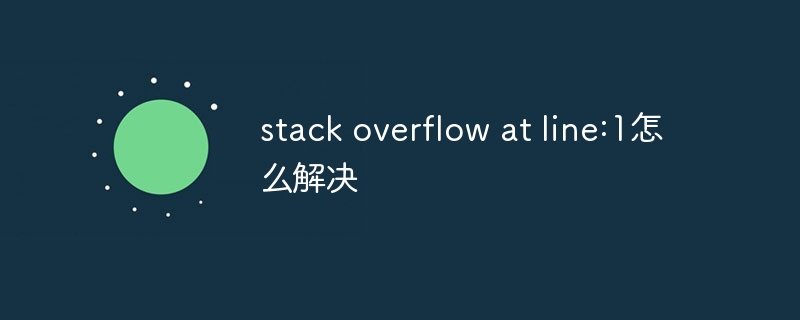How to solve stack overflow at line:1
stack overflow at line:1Solution: 1. Check recursive calls; 2. Optimize recursive algorithm; 3. Increase stack size; 4. Reduce memory consumption; 5. Use iteration instead of recursion; 6. Debugging code .

StackOverflowError is a common programming error that usually occurs when recursively calling an infinite loop. This error indicates that the stack memory is insufficient to handle the depth of the function call, causing a stack overflow. This article will introduce how to solve StackOverflowError error to help programmers handle the problem efficiently.
1. Check for recursive calls
First, check whether there are infinite recursive calls in the code. Recursive calling is a way for a function to call itself. Without the correct baseline conditions or recursive termination conditions, it can lead to an infinite loop, which can lead to StackOverflowError error. Make sure the logic of the recursive call is correct and the termination condition is clear.
2. Optimize the recursive algorithm
If the recursive algorithm is necessary, you can try to optimize the algorithm to reduce the number of recursive calls. For example, you can use tail recursion to optimize recursive algorithms. Tail recursion means placing the recursive call at the end of the function without any subsequent operations. This allows the compiler to optimize recursive calls into iterative calls, thereby reducing the number of stack frames used.
3. Increase the stack size
By default, the stack size of the Java virtual machine is limited. In some cases, the stack may not be large enough to handle deeply recursive calls. The stack size can be increased by setting the -Xss parameter. For example, you can use "-Xss2m" to set the stack size to 2 megabytes. However, it should be noted that an excessively large stack size may lead to excessive memory consumption, so it should be adjusted according to the specific situation.
4. Reduce memory consumption
StackOverflowError The error may be caused by the program taking up too much memory space. Excessive memory usage may result in insufficient stack memory to handle the depth of the function call. Therefore, optimizing memory usage is one way to resolve this error. It can avoid creating a large number of objects, release unused resources in a timely manner, reduce memory usage, and thereby reduce the risk of stack overflow.
5. Use iteration instead of recursion
In some cases, iteration can be used instead of recursive calls to reduce the use of stack frames. Iteration is a loop method that can use a loop variable to simulate the recursive process. Although iteration may increase the complexity of the code, it can effectively avoid A StackOverflowError error occurs.
6. Debugging code
If the above method still cannot solve the problem, you can use debugging tools to analyze the code and locate the error. Debugging tools can help determine what caused the StackOverflowError The specific code location of the error and provide more detailed error information. You can use breakpoint debugging, log output, etc. to assist debugging to find and fix problems.
Summary:
StackOverflowError The bug is a common programming mistake that usually occurs when recursively calling an infinite loop. Ways to resolve this error include checking for recursive calls, optimizing recursive algorithms, increasing stack size, reducing memory consumption, using iteration instead of recursion, and using debugging tools. Handle it with reasonable methods and techniques StackOverflowError errors can improve the stability and robustness of the code, thereby helping programmers better solve problems.
The above is the detailed content of How to solve stack overflow at line:1. For more information, please follow other related articles on the PHP Chinese website!

Hot AI Tools

Undresser.AI Undress
AI-powered app for creating realistic nude photos

AI Clothes Remover
Online AI tool for removing clothes from photos.

Undress AI Tool
Undress images for free

Clothoff.io
AI clothes remover

Video Face Swap
Swap faces in any video effortlessly with our completely free AI face swap tool!

Hot Article

Hot Tools

Notepad++7.3.1
Easy-to-use and free code editor

SublimeText3 Chinese version
Chinese version, very easy to use

Zend Studio 13.0.1
Powerful PHP integrated development environment

Dreamweaver CS6
Visual web development tools

SublimeText3 Mac version
God-level code editing software (SublimeText3)

Hot Topics
 1389
1389
 52
52


